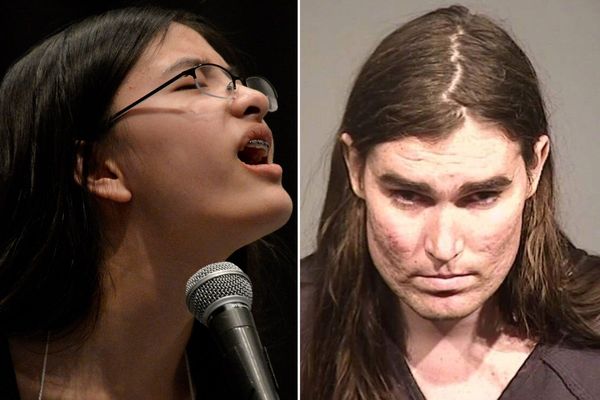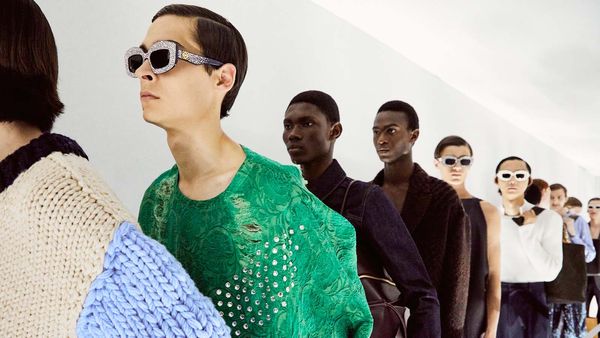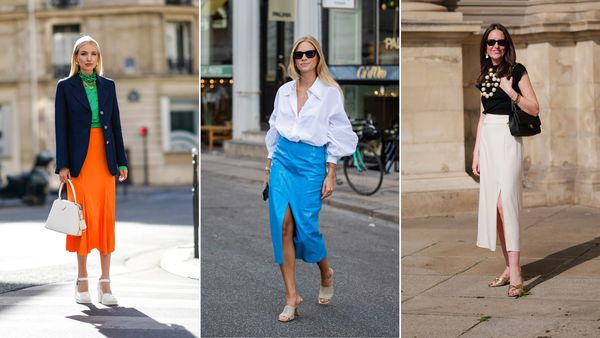
It might be ridiculous to judge the state of the nation on recent Tory party hairdos, but as a visual barometer for the mood shift happening in men’s fashion, it’s on the money. What Boris Johnson’s hair stood for – infantile anti-chic – versus what Rishi Sunak’s does – slick, tidy and grownup – aligns with current trends in menswear.

Suits and tailoring sales are on the up. The trainer bubble is bursting: Balenciaga’s latest catwalk featured not a single pair, while its designer Demna said recently in the New Yorker that he could no longer stand looking at his infamous “ugly trainer”, the Triple S. Ties have returned to fashion week at the likes of Dries Van Noten, Prada and Paul Smith and on K-pop stars such as Jeno and Johnny Suh. Meanwhile, loud, logo and/or gimmicky clothing designed for showing off on social media is being ditched in favour of a quieter approach to luxury – a topic that has swollen around the wardrobe of the last season of Succession. It’s an evolving direction best summarised by David Hockney: “I hate what men wear today – it’s just sports clothes, where’s all the style?”
Menswear’s obsession with tracksuits, trainers and casual fashion dominated much of the 2010s. But by the time we’d hit the pandemic, there were signs that it had started to wane. Athleisure was beginning to be replaced by tailoring – in high fashion, this was most notable by Off-White’s founder Virgil Abloh at Louis Vuitton, Kim Jones at Dior and Riccardo Tisci at Burberry in 2019. All three designers had been associated with bringing a sportswear feel to menswear, but this time each opened their debut show with a suit. Shortly after this, the high street followed with brands like Arket and Cos selling as much tailoring as their usual casual wear.
‘Then came spring 2020 and the tracksuit era: a three-year style blip. Now with red carpets in full swing, IRL meetings back on the agenda and designers pivoting to collections based more around suits and elegance, the male wardrobe is pushing back against sartorial slackers.

Have you noticed that the men most stylistically in the public eye are dialling down all the fashion faff and dialling up a more minimal, sleeker look? See Pedro Pascal’s tidy monochromatic Oscars ensemble or Vincent Cassel’s lean suiting star turn in the current Prada campaign. See also the Met Gala, where among the many homages to Karl Lagerfeld, the men that stood out (aside from Jared Leto dressed as a giant cat) were quietly attired: tennis star Matteo Berrettini (in a loosely cut black trouser), Bill Nighy (in trademark impeccable suiting by the Anthology team), and actor Ke Huy Quan (in a grey pinstripe two-piece). Pascal also gave a masterclass here – in his coat, tie and shorts ensemble: if you remove the coat, you have the perfect tailored look for summer.
It’s also happening on TV, now one of the biggest influences over our wardrobes (did I mention Succession?). The cast of Netflix’s Transatlantic are wearing tie-pins and a broad lapel, while Richard Madden in Citadel is all action in classic black suits. Even in politics, we have a new style hero: Humza Yousaf, with his sleek haircut, an occasional embroidered sherwani and a fresh take on contemporary grey tailoring.

If the really big fashion-fashion shift takes place next season – the autumn/winter 2023 menswear shows were all about glorious suits and tailored overcoats à la Saint Laurent – the look is already happening for summer too. Tailoring sales are up 70% at John Lewis – some of which is being led by linen that is arguably a knock-on effect of a post-pandemic wedding boom and warmer temperatures.
At Marks & Spencer, formalwear is spiking at 42% up year-on-year and ties have returned with a 75% uplift. Both are seeing swift chino sales (see George in Netflix’s Beef) styled with a neat knit. At Matches, the online retailer reports a massive 208% growth in their suiting and tailoring offer, while T-shirts under suits (very Timothée Chalamet) or more summery stripes – see Ethan Hawke’s striped double-breasted suit blazer with a contrast striped shirt, no tie, at Cannes – also have new elegance.
Some of the biggest culprits of this over-casual look that chimed with pandemic fashion originate in Silicon Valley. “I think a big part of the tech-sphere embrace of casual was to look modern and current,” says Robert Williams, luxury editor at Business of Fashion. “As the pressures on that industry have shifted, and what the narrative around that industry’s disruption really means in society – positive and negative – there is maybe more pressure on people in these positions of power to project seriousness again, and authority.” The dress-down CEOs – think Mark Zuckerberg’s hoodies and Evan Spiegel’s black T-shirts – have fallen out of favour. Even disgraced entrepreneur Sam Bankman-Fried wisely sidelined his ratty T-shirts for his recent court indictment.

The last time smartness was this hot was circa 2007/8, when Mad Men’s suited and booted aesthetic was referenced across the board in menswear. But that had given way to athleisure and sports luxury by the mid-10s. Plus, as Williams says, during that decade, the shift to shopping on smaller screens, the rise of e-commerce and social media was much better for selling logo merchandise.

Tom Saunders, menswear lead at John Lewis, says that the biggest shift from the Mad Men era is in silhouette; tailoring is much less stiff now. “We’ve softened off all the shoulders lines in our suits, we’ve softened the construction and raised the arm holes so you get a lot more movement, but you still look sharp and it’s comfortable to wear,” he says of the John Lewis mainline range.
The new look is about finding a comfortable way to appear more pulled together. “There has been a huge increase in demand for soft tailoring in our collections. Our jackets and two-pieces are selling very well,” says Nick Wakeman, founder and creative director of Studio Nicholson, a British brand whose unpretentious style led to a collaboration with Zara, and their shirts being worn by Cate Blanchett in Tár. Their staple tailored jackets – influenced by Japanese fashion – feature no shoulder pads or canvassing, making them breezy to wear.
“Menswear just feels a bit more intellectual now,” says Wakeman, “and it’s more experimental, which is fantastic.” Bianca Saunders, a rising star in British fashion, has taken the idea of easy tailoring one step further with suit jacket designs that are made without fastenings so they can be pulled over the wearer’s head like a pullover.

Does that mean we all need to ditch our WFH hoodies? No, says Williams, “but the market for a hoodie with a logo splashed on it might be cooling.” The backlash against clickbait fashion and hype product is a clear factor in this return to dress-up fashion. “Those sudden trend pieces feel a little bit cringe,” says Adam Baidawi, deputy global editorial director of GQ.
There are other reasons for this shift, which is less about trend: it’s simply a change from ostentatiousness. Red-carpet dressing has brought new ideas around how men can approach suiting in more individual ways. Many of us are trying to shop more responsibly by buying less, and these more timeless-looking clothes – a lot of which we probably already own – are a sensible choice in that regard. It feels like a win-win: a modern take on dressing that feels, and does, good.
Photographer: Iain Anderson. Stylist: Helen Seamons. Assistant stylist: Roz Donoghue. Models: Sanjay and Keon at Models 1 and Theodor at IMG. Set stylist: Helen Macintyre at One Represents. Grooming: Natalie Shafii using Augustinus Bader and Sam McKnight










